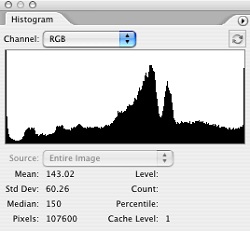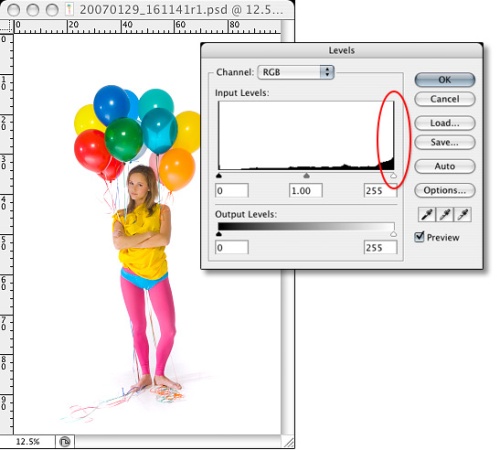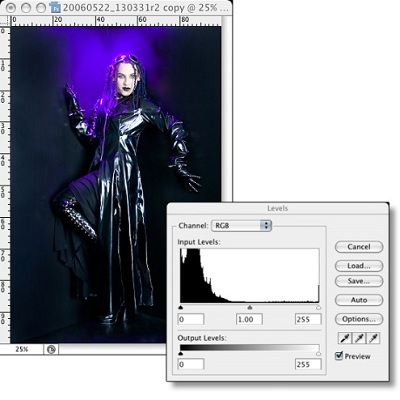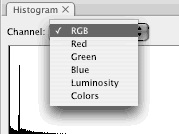What should your histogram look like?
What exactly are you supposed to be looking for when you check the histogram for proper exposure? What does a correct one look like?
The contents of a histogram simply reflect what was captured or is in the file. It’s a graphical representation of how many pixels there are for each brightness level, scaled to fit the available space. The higher the peak, the more pixels of that brightness are there. Black is on the left, white is on the right, and everything else is in between. (“Middle gray” will usually be around 110 to 130, depending on the gamma of the file; it is not automatically 127/128.)
What was captured or is in the file reflects what was in the scene combined with how it was exposed (and possibly color space).
A typical middle-key image will show that the majority of tones are in the mid-range, with some darker and lighter areas.

A high-key image, even properly exposed, may well have a significant fraction of the image at 255 (see the image and histogram with the white background), while a histogram like that could easily mean overexposure for a “normal” or low-key image.

The opposite applies for a low-key image, where a lot of image data could legitimately be at 0.

That said, most “normal” images with a lot of pixels at 0 or 255, or a lot of pixels crowded near one edge of the histogram and nothing or very little near the other, are usually improperly exposed or scanned.
If you keep in mind that anything at 0 or 255 is without detail, that will help. There aren’t that many other “rules” that are universal. That also means that anytime one channel has something at 0 or 255, you have less detail, and if there are two channels that way, you’ve lost a lot of detail. When all three are at 0 or 255*, you have no detail. (*That includes such examples as (0,255,0)—pure green, no detail; it doesn’t have to be (0,0,0) or (255,255,255)).
As an example of non-universal rules, different applications and different cameras treat composite histograms in different ways. Some show luminosity, some show peak values per channel, and some show the green channel as if it were the composite. Additionally, most cameras display histograms based on the in-camera JPEG settings, which may not reflect what is captured in a Raw capture.
For most images, it’s not critical to know that Luminosity and per-channel views are different; the differences are usually fairly minor. For images with very saturated colors, however, the two can give very different results, and knowing which is being displayed can help you avoid problems.
A recent version of Photoshop will let you choose how and what to display.

On my website, I’ve got a Histogram Quiz that contains sample histograms that can be used to help visualize the contents of an image based on the histogram. Those samples emphasize the unusual, however, as many common histograms will look fairly mountain-like: high in the center and low at the ends.
All that said, from a working perspective, a “good” histogram will have information stretching from as dark as you want anything in the image to be (usually a pure black) to as light as you want to have in the image (usually a pure white). A histogram that doesn’t cover the full range is generally describing a “flat,” or low contrast, image. Unless that’s intentional, stretching the data via Curves or Levels will usually help.


January 11, 2013 at 10:20 am, Dick Hogg said:
As a photographer that has worked in TV as well as stills, one must understand that digital photography is really what we use to call a frame grab for lack of a better way to understand it. In video terms we try to keep the video level at 100% otherwise it is too “hot” or too dark.
Video is more like shooting slides of days gone by. Using a histogram is really just watching “video levels” and once again digital photography is more like shooting slides, thus the need to keep your levels from being over or underexposed.
You just can’t shoot digital photography like negative film they really are not compatible.
January 09, 2013 at 12:34 pm, Jim Daniel said:
Coming from the 4X5 Shjeet film world, I appreciate ANY input in advance of walking away form the shoot. WE used Polaroid film for hints (at best) about what was on the film. The Histogram doesn’t have to be a perfect rep[resentation to be analized like an EKG to make me very happy. Just having some indication that there’s a graphic representation coming close to what I want is fabulous.
October 11, 2012 at 5:27 am, Chris Biele said:
Also keep in mind that if you are shooting images with the histogram up against the right wall (over exposed) you will be clipping the detail in the highlights and may not be able to get any of that detail back. How much you can pull back the exposure depends on if you’re shooting raw or jpeg, what type of camera you’re shooting with and what you use to edit your images.
A good rule of thumb, unless you’re shooting for deliberate whites or blown out highlights, is to get your histogram just touching 255 (the right wall) without going over. Also you should use your RGB histogram rather than the luminance histogram. The luminance histogram is an average of the 3 different channels, so if there is a dominant color in the scene like a red sunset then your red channel will likely be over exposed.
This is called “exposing to the right” and actually has more benefits than just a nicely exposed image SOC. Brighter parts of your image have more color information so you will get better results when editing. This includes less posterization and less noise.
There is a very informative article on the subject on the Luminous Landscape website:
http://www.luminous-landscape.com/tutorials/expose-right.shtml
Hope that helps!
October 03, 2012 at 12:33 pm, Andrew said:
I feel bad because it makes me feel like less of a photographer, but I never have once looked at a histogram. I’m not the most technical guy around…I think my photos are pretty decent but…ugh. Histograms just don’t seem to make a whole lot of sense from the perspective of different lighting situations and objectives of the shot. I’d understand if I shot a lot of high-key commercial stuff, but I don’t.
January 18, 2012 at 5:36 pm, Sdad said:
What is the “gamma of the file”, please?
January 18, 2012 at 2:00 am, Tri Minh Nguyen said:
If it look good then it’s probably good, don’t worry too much about your histogram.
January 09, 2013 at 10:16 am, jerrymat said:
When I started digital photography I had this viewpoint. I also thought it OK to take all pictures in jpeg format. It took me a while but now I deeply regret not using the histogram at every light setting change (as though it were a light meter) and not using the raw format.
January 17, 2012 at 7:18 pm, Riddell said:
A good explanation, though not really taken far enough, because the histogram can totally change dependant upon the situation, even if its perfectly exposure and nothing has changed.
For example shootingt a black model hi key just as in your example, will give a histogram exactly as depicted.
But without making any alterations if you then zoomed in tight to that models face, you are now going to see a histogram like your low key example.
Its still perfect exposured and nothing has changed except the content of what is actually in the frame.
Paul.
http://www.photographybyriddell.co.uk
September 28, 2011 at 6:01 pm, Steven Bagley said:
That is one of the best explinations I have read about Histograms..
Thank you